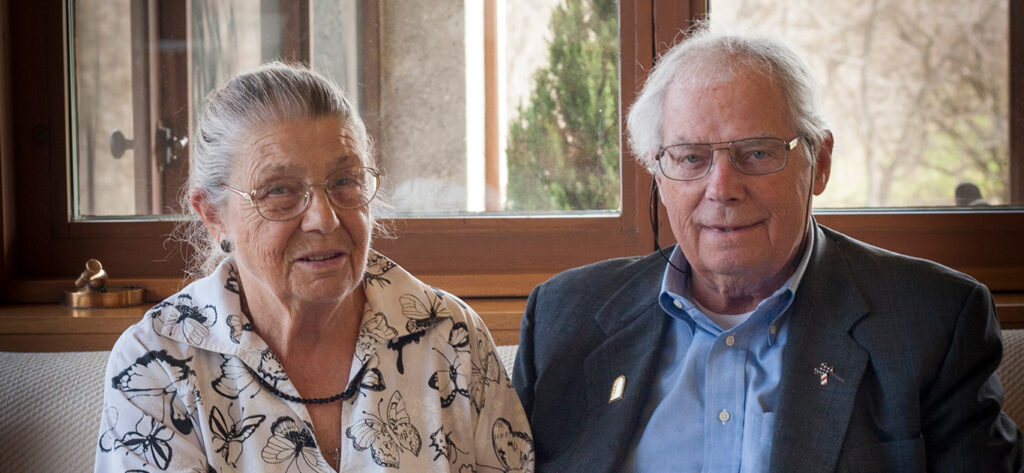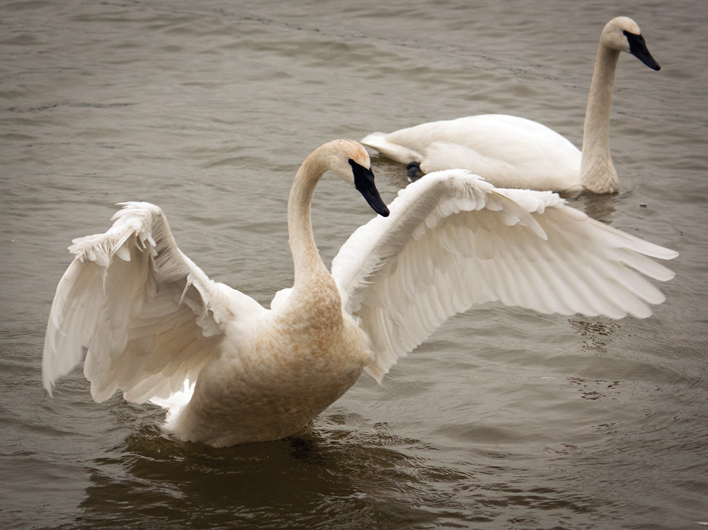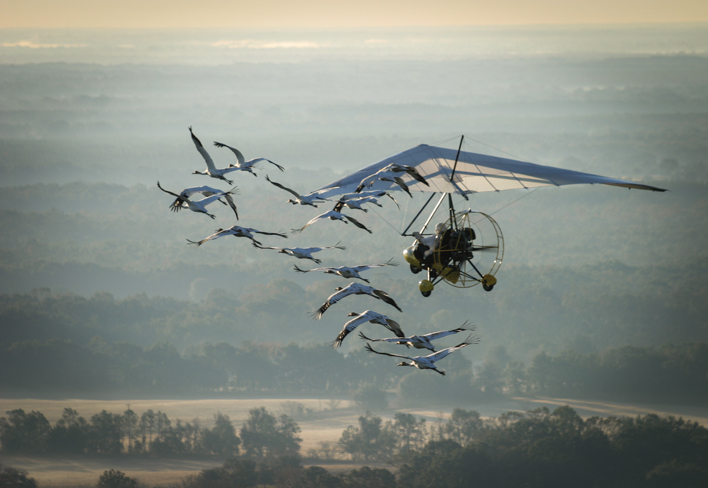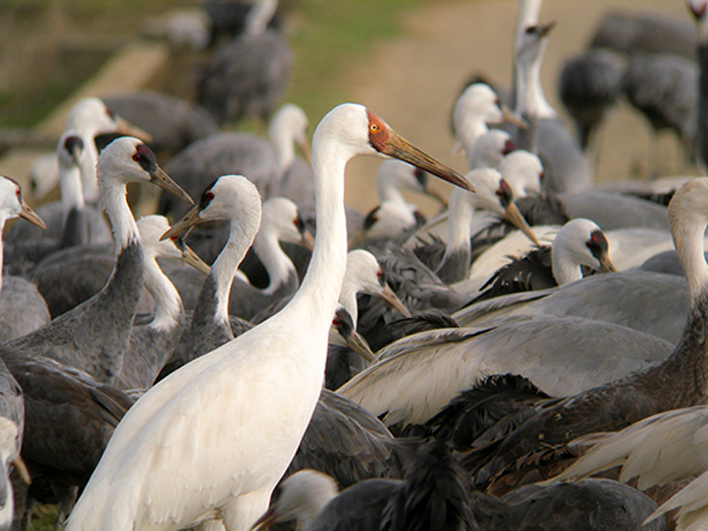
Terry Kohler is the son and grandson of Wisconsin governors, and descendant of the men who founded both the Kohler and Vollrath manufacturing companies. He joined the Air Force in 1955 and flew B-47 bombers. Later he earned bachelor’s and master’s degrees in industrial management from the Massachusetts Institute of Technology, and expanded the Vollrath Company from $13 million in annual sales to more than $300 million. An enthusiastic outdoorsman and sailor, he is a lifetime member of the National Rifle Association and Ducks Unlimited. Terry ran as a Republican for Wisconsin governor in 1982. He lost the race, but won his wife, Mary, who worked as his campaign manager. Mary now divides her life into “BT” and “AT”—“before Terry” and “after Terry.” A passionate birdwatcher, fossil digs participant, and local nature preserve teacher, she learned to fly after meeting Terry, and they have shared the controls over many thousands of miles, often on animal sorties, conservation surveys, or research jaunts of various sorts. On hundreds of occasions the Kohlers have donated use of their company airplanes and helicopter for crucial transport in endangered-species restoration work. Mary has managed much of their philanthropic giving and directed tens of millions of dollars to conservation, as well as other causes. During their interview with Philanthropy, the couple paused several times to point out wild turkeys, deer, and songbirds in the woods outside their Sheboygan, Wisconsin, home. They split their time between the Badger State, a Florida house located in a bird refuge, and a Chilean fishing camp.
Philanthropy: Tell me about your love for nature. Did you always enjoy being outdoors?
Terry Kohler: I’ve always been a hunter and a fisherman. To that extent, nature has been where I did my thing and had fun. When Mary and I came together, she began to teach me more about it.
Mary Kohler: My father was very interested in birding and wild flowers. We had three bird feeders. I asked my dad one day what bird was singing. He said, “You go find out.” It took me awhile, but it was a veery thrush. Then, as a married young adult with children, I volunteered as a teacher at a nature center.
Philanthropy: How did you get involved in bird conservation?
Terry Kohler: One day in 1987, after we helped elect Tommy Thompson as Wisconsin governor, I got a telephone call from him. He said, “Say, Terry, we’ve got our Department of Natural Resources trying to replace the trumpeter swan in Wisconsin because they were all shot out of existence prior to 1900. I know you’ve got a corporate jet. Can I talk you into flying up to Alaska to get swan eggs and bring them back to Wisconsin?” I said, “When do we leave?” Mary and I jumped into our Cessna Citation business jet. She’s a pilot as well. We picked up the DNR guys and flew up to Alaska and had fun doing this and that, between looking at the mountains and chasing all over the Minto Flats.

Philanthropy: You started with the trumpeter swan eggs. How did you get involved in cranes?
Terry Kohler: I got a call from George Archibald, who was the head of the International Crane Foundation, based here in Wisconsin. “Terry,” he said, “I heard from my friends at the DNR that you and Mary flew up and got eggs back with you from Alaska and you’re going to do it again next year. You know, we’ve been trying to put together a program to get whooping crane eggs down from northern Canada, so it would be really neat if you would fly up there and pick up those eggs in spring and fly them back down to ICF, where we could go ahead and hatch them so we have ourselves some whooping cranes here, too.” I said, “When do we leave?”
Mary Kohler: And we made two trips every spring for six years, one for the cranes and one for the swans. The timing depended on when the eggs were ready to be picked off the nests.
Terry Kohler: Our company that makes food service equipment designed and built an insulated container for the eggs, with heat and temperature-sensing devices. We can bring down 60 eggs at a time. The cranes went to the International Crane Foundation, and the swans went to the Milwaukee Zoo.
Philanthropy: Were they able to reintroduce them into the wild?
Mary Kohler: Yes. They developed a system of raising them without human contact. The people that take care of them are covered with white sheets and their arms are disguised to look like cranes, so that the birds don’t get attached to humans. They raise them until they’re able to go out on their own.
Terry Kohler: We started bringing whooping cranes to Wisconsin because the numbers in the world were very small. It went down to 16 or 17 back in 1941. Since then, there have been serious conservation efforts and the shooting has gone down rapidly. We ship people off to jail for shooting one of those birds. In any event, ICF decided they wanted to establish a migratory flock in the eastern half of the United States. There’s a guy I happened to know, Bill Lishman, who was leading Canadian geese in migration with an ultralight, which is a little tiny airplane with a big, big fan in the back of it. I saw his book Father Goose, which later inspired the movie Fly Away Home.
I bought the book, and I read the darn thing and I said, “Hmm,” and I sent it over to George Archibald. I said, “George, I know you’re going to not take this so seriously but, nonetheless, I think this guy’s got an opportunity for us to go and fly cranes via ultralights.” He laughed. But he got the book and a video that showed how it was being done.
He called me back. He said, “Terry, I’m not laughing anymore.” He then sent this information to the board of directors and to others. They were laughing to begin with, too. But all of a sudden they were saying, “We’re not laughing anymore.” The next thing you know they’re trying it right here in Wisconsin. We’ve been helping to fund that.
Mary Kohler: Our employees have been involved in this as well. In addition to the ultralights, they have small regular airplanes. Some of the cranes stray, and somebody else will go look to see where they strayed, or chase away eagles.
Terry Kohler: Little by little we were able to increase the number of these cranes we’re leading down to Florida with the ultralights. We’re still taking them down there. You only have to do it once; they return, and repeat the migration on their own after that. There’s also a nonmigrating flock of whooping cranes in Florida which we started many years ago, which unfortunately is being decimated by bobcats. But we have now started moving birds over to Louisiana’s big isolated islands. We’ve now got 30 or 40 birds down there.

Philanthropy: What are some of the ways environmental giving can go wrong?
Mary Kohler: I think one of the chief ways is to have the government take over. Too many rules don’t help, and too much protected land is good in some ways but it has created a lot of problems in other ways. In our opinion, small, privately organized conservation groups, such as ICF, are the best. Some of the bigger organizations have gotten into spending most of their time trying to get laws passed and very little of their time researching practical solutions.
ICF is studying a place in China called Poyang Lake, a major wintering site for Siberian cranes. It is threatened by a big dam on the Yangtze River. ICF has been researching what the cranes eat, what the water level has to be like, how it impacts the people that live there, and how those people can get along with the cranes and still support themselves.
One of George Archibald’s major themes is that when you help animals or birds you must not hurt the people in the area where you’re trying to help. In Poyang, the locals are now making very high-end straw products out of reeds that grow naturally in the lake area. That has been a boon because their previous fishing jobs involved a system of damming things up and then letting the water go that was not compatible with what the cranes needed. So if you’re not going to let the people catch fish, you better figure some other way that they can make money.
Philanthropy: Tell me about your work with the Onion River in Wisconsin.
Terry Kohler: It had been turned into a couple of trout farms and some racehorse farms. There were 26 or so dams out there, which had blocked most of the headwaters for trout reproduction, so there was no longer a satisfactory trout stream. The DNR couldn’t buy the property because there were businesses on it. So we bought it, about six properties in total, for three million bucks. We proceeded to get rid of the businesses that the DNR couldn’t buy, and then little by little the DNR was able to buy it back from us. The lands are now state-owned and they’re available for fishing by anybody with a license. I still hold the state record for tearing up 24 of the dams in one week. Trout are another passion of mine. We like to return wildlife to where it belongs and try to do it without hurting people as a result.
Philanthropy: Tell me about your decision to spend down the $20 million Charlotte and Walter Kohler Charitable Trust, named after Terry’s father and stepmother. Spending down is more and more popular these days, but it was rare back when you chose that course, in 1997. Why did you do it?
Mary Kohler: We made the decision quite early on that we weren’t going to be like the Ford Foundation and other places like that. We didn’t want it to go to people who wouldn’t have our opinion of what sort of things are good to give to and what policies you ought to have, which has happened to most of the big foundations. So we decided we would give it all away, which also allowed us to make some quite sizable grants.
Philanthropy: Do you have a philosophy of giving?
Mary Kohler: I like to give to pilot programs because most people won’t. The pilot program may be a complete dud, but then they learn something that way, too. Some things have turned out extremely well. Over the years, we have given FREE, the Foundation for Research in Economics and Environment, a fair amount of money, several hundred thousand. One of its projects has been to hold seminars for federal judges with well-respected experts in economics and the environment. Judges must decide cases in which the environmental impact is a feature, yet a lot of them don’t know much about it.
Philanthropy: You’ve given more than $5 million to a number of programs that work to strengthen marriage, locally and nationwide. What does that interest stem from?
Terry Kohler: My divorce in my first marriage and the fact that intact families are most successful for the upbringing of children. There are tons of statistics to bear that out. Anybody that tries to argue that point isn’t reading. I’m not trying to imply that everybody who is getting or has gotten a divorce is bad. I’ve failed in that department myself. But we ought to make it as easy and desirable as possible for people to maintain intact families.
Philanthropy: It seems to many that marriage is a lost cause in America. How do you go about reversing a cultural trend?
Terry Kohler: It’s happening. That reversal has begun. You see it here in Sheboygan.
Mary Kohler: There’s a program called Greater Marriages for Sheboygan County that works with people on two common problems: money and communication. It’s just the same story over and over. If you can get couples to deal with some of those issues and not to look at it as though they’re alone in facing them, it’s amazing the good results you get.
Terry Kohler: We have had some 24 mentoring couples volunteering. Many of them have come out of the program in years past. They take on a couple, and they work with them typically for three to six months. Having them all sit down and talk about the problem that both couples have had and one couple has recovered from, that’s the whole system. It’s working incredibly well. Professional marriage counselors have a success ratio of about 28 percent. Greater Marriages for Sheboygan County has an overall success ratio of 87 percent. We got a communication last year from the secretary of the Sheboygan County records section. She said, “I think you must be having an impact. Our divorces have gone down rather dramatically.”
Philanthropy: Tell us about your political involvement in Wisconsin.
Mary Kohler: We have been, to the extent of the law, big givers of money to candidates. We have also done a lot of hands-on work; Terry has run for office, and I’ve run campaigns. I’ve knocked on doors, distributed literature, made phone calls. I’ve done all the grunt work. We also give to conservative, cultural 501(c)(3)s. Recently we had a party to fundraise for a small, nonprofit magazine put out in Stillwater, Minnesota, that needs to expand its readership. It’s a journal called the St. Croix Review.
Terry Kohler: Let’s face it: The media is largely aimed to benefit the left side of the political spectrum. The average person does not have access to the St. Croix Review, even to the Wall Street Journal. So we’ve done work with (c)(4)s, on issue-based advocacy, to make the real issues more obvious to people.
My aim has been trying to change the character of the institutional base. The unions have been a very dominant force in this state. This was a socialist state. Back in the ’20s there were 23 socialist operatives on the payroll of the state! My grandfather and later my father were able to move that to a significant extent, but the unions were still dominant.
So with two or three of my associates around the state, we formed a coalition. Wisconsin was the fourth state in the country to put in place a Club for Growth, a (c)(4), and I was very active in that. We have also been big givers to Right to Life Wisconsin, which is a (c)(3) and has a (c)(4).
Together, our coalition was responsible for moving some $7 million in the 2012 election. We changed the character of Wisconsin.
Philanthropy: Tell me about WisconsinEye, a project to which you gave $300,000. It put cameras in the state house so that citizens could watch the legislature’s proceedings online.
Terry Kohler: WisconsinEye is the only video-based organization that looks at what’s going on inside the state government¬—the only one in the USA that’s doing it with private money, not government money. It’s not supposed to be a traditional news report; it just films the actual operations in the government, which your normal video media doesn’t even have. I supported WisconsinEye because it was unbiased, aimed at transferring information from real proceedings.
Philanthropy: What do you consider your greatest philanthropic achievement?
Mary Kohler: I would have to say a pittance of money, somewhere between $5,000 and $25,000, that I gave to a young man whose name was John Lenczowski, who had this notion that he was going to start a graduate school in international relations from the free market perspective. That’s now the Institute of World Politics, a growing organization. I gave him money when he had no money and didn’t know who else to ask.
It’s the money that comes at an absolute crucial time that helps people most. We once befriended a young Chinese man who had been studying at an American university at the time of Tiananmen Square and was afraid to go back home. He had been videoed in New York City while protesting against the Chinese, and was spotted on TV and identified. He didn’t have any money and needed to get another scholarship to stay in the States. What we gave was a pittance. It was like a couple thousand dollars. Almost anybody could’ve found that much money if they really thought it was important. We gave it to him, and that money kept him here. He’s now a paleontologist with Beijing University.
Terry Kohler: I’m most proud of receiving the Charles Lindbergh Award for our efforts with cranes and swans. Our bird conservation efforts have had the most widespread international impact.
Philanthropy: How has your faith influenced your giving?
Terry Kohler: Well, if you believe in God, believe in Christ, He’s going to take care of you. All you have to do is serve others. It’s a pretty straightforward Biblical position. We haven’t suffered. The good Lord has been extremely generous with me, let’s put it that way. What would we do with the money if we kept it?
Saving the Siberian Crane with an Egg Expedition Across Russia
Terry and Mary Kohler’s adventures in Russia started the same way many of their others did—with an appeal for help from a friend, and Terry’s standard response: “When do we leave?”

The Siberian crane is one of the most beautiful and endangered animals in the world, and in 1994, the International Crane Foundation’s George Archibald, a good friend of the Kohlers, needed to transfer precious eggs produced by captive birds in the U.S. to the wilds of Russia. He couldn’t do it without aviation aid. “So we flew over to the International Crane Foundation and picked up George and his wife and a whole big box of eggs,” says Terry.
Once-vast western and central flocks of Siberian cranes that wintered in Iran and India were reduced to fewer than ten birds. Only a Chinese flock was still prosperous, with more than 2,000 members. Biologists worried that the species’ chance of survival depended on just one group of cranes: What if human development or predators managed to wipe out the Chinese flock? So Archibald and other conservationists conceived a plan to place Siberian crane eggs in the nests of common Eurasian cranes, which scientists hoped would teach their Siberian cousins new migratory patterns that avoided dangerous hunting grounds over Afghanistan and Pakistan, as well as less picky eating habits.
The Kohlers’ journey to Siberia, which required a circumnavigation of the northern hemisphere, was challenging. Their incubator, custom-built by a Vollrath employee on the Kohlers’ dime to carry swan eggs from Alaska, overheated its battery whenever it was plugged into European outlets at night, putting the eggs and the team’s entire mission at risk. When the last of the Kohlers’ heavy-duty voltage convertors failed, Mary desperately dug out a tiny convertor she had used for ten years to boil water for tea while traveling. It worked better than all the others, stopped the egg carrier’s system from crashing, and saved the eggs.
Other problems had to be solved. Overcast skies in Canada required Terry to land using military-style systems he hadn’t used since leaving the Air Force nearly 40 years before. Private jet parts and service would be unavailable in Siberia, so maintenance and fallback plans had to be carefully arranged. Flying a private American plane across Russia just a few years after the fall of the Berlin Wall required the team to steer their way through gobs of regulation and red tape, follow strict routes and timetables, pay cash landing fees at every airport, and even take on board a Russian “navigator”—“probably a part-timer with the KGB,” according to Terry.
Finally the group was ready to plant Siberian crane eggs into foster nests. “We flew up to the Siberian north coast that day with a military helicopter planting eggs,” Terry says. The helicopter could not touch down on the boggy land, but hovered just above the water near each Eurasian crane nest. Russian scientists would leap into the water, Terry would open the egg box on his lap, Mary would pluck out an egg, which George Archibald would hand out the open door to the scientists below. Then this delicate game of hot potato would be repeated.
After a 13,000-mile journey taking 13 days, the crane enthusiasts flew home over Alaska, the second group in history to go around the world across the Russian land mass in a private plane. Two weeks later, a scientist in Siberia reported that all the crane eggs planted by the team had hatched. The first two were named “Mary” and “Terry.”
This is adapted from Philanthropy’s interview with the Kohlers and the book, Chasing the Ghost Birds: Saving Swans and Cranes from Extinction by David Sakrison, a superb resource for anyone seeking to learn more about the Kohlers’ crane and swan conservation.
